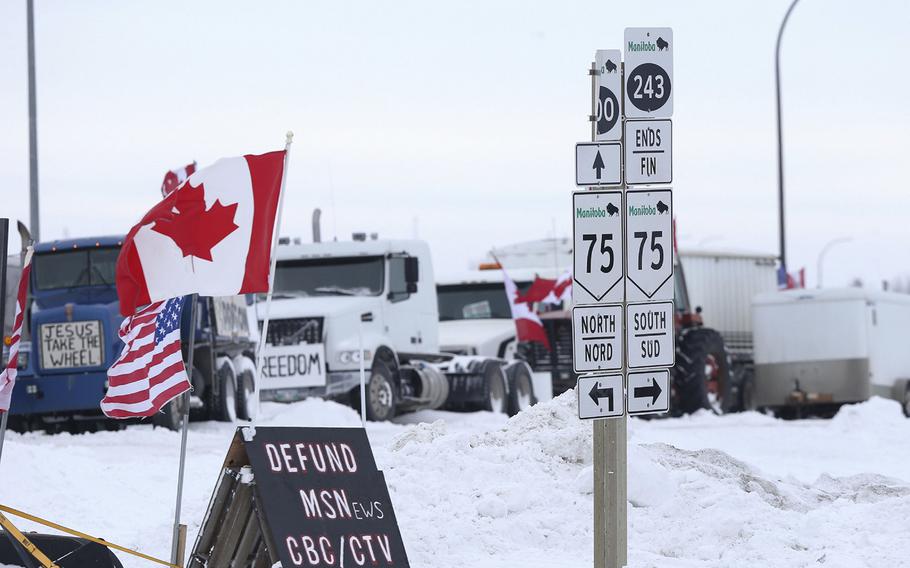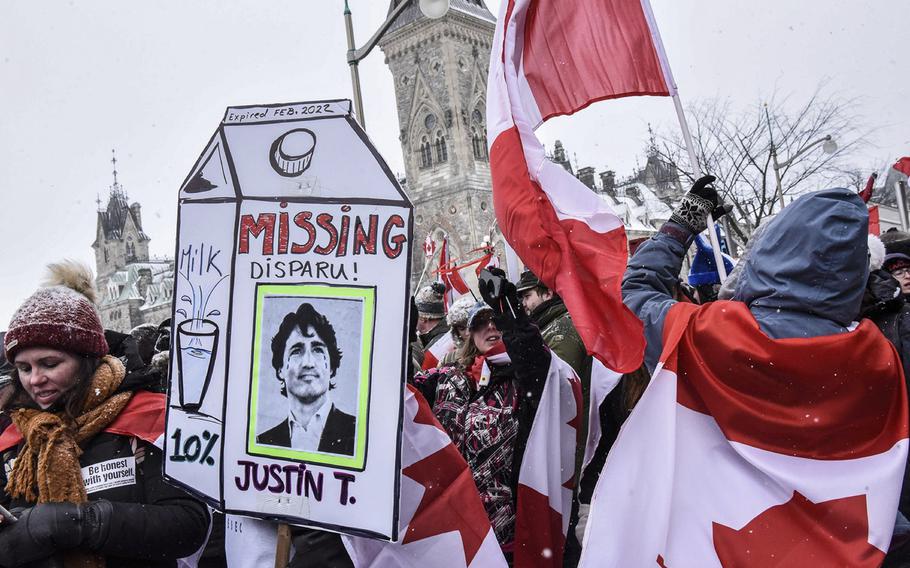
Trucks blockade the U.S.-Canada border crossing during a demonstration in Emerson, Manitoba, Canada, on Feb. 13, 2022. (Shannon VanRaes/Bloomberg )
Stars and Stripes is making stories on the coronavirus pandemic available free of charge. See more stories here. Sign up for our daily coronavirus newsletter here. Please support our journalism with a subscription.
TORONTO — Prime Minister Justin Trudeau will testify before a public inquiry Friday on his decision to invoke never-before-used emergency powers to clear the self-described "Freedom Convoy" demonstrations by protesters, including some truckers, who for several weeks paralyzed the nation's capital and snarled trade at major U.S.-Canada border crossings.
His highly anticipated testimony will close the six-week inquiry in Ottawa, where life was upended in late January when big rigs and other vehicles rolled in to blockade roads, including the main drag in front of Parliament, to protest coronavirus pandemic health measures and Trudeau's government. The demonstrations lasted roughly three weeks.
In a country where officials are careful to hew closely to talking points and requests for public records take years to process, the inquiry has offered a rare peek behind the curtain at the mechanics of police and government - and the dysfunction and rivalries that complicated the response to the blockades.
"At the municipal level of police and the interaction between police governance, police and the municipal government, there was infighting, incompetence and lack of preparedness," said Michael Kempa, a criminologist at the University of Ottawa. "At the provincial level, there was total indifference to responding with provincial powers . . . and then [at the level of] the federal government, there was mass confusion."
Thousands of pages of documents, including text messages between cabinet ministers and intelligence reports marked "secret," have been introduced as evidence, and more than 60 witnesses have testified. They include Canada's top cop, chief spy, mayors of cities big and small, cabinet ministers and convoy leaders.
Few witnesses have emerged unscathed. A lawyer for convoy organizers was ejected after seeking to advance a baseless conspiracy theory. A cartoon in the Globe and Mail depicted inquiry participants as clowns. The exception was Paul Rouleau, the judge leading the inquiry, who thinks, "Beginning to see a pattern here . . ."
At issue in the inquiry is Trudeau's invocation on Feb. 14 of the Emergencies Act, a 1988 law that's supposed to be a tool of last resort, available only when no other law can respond to a national emergency. He revoked the act on Feb. 23, days after a massive police operation cleared the Ottawa blockades.
The law gave authorities sweeping powers to create no-go zones, to temporarily freeze bank accounts belonging to demonstrators and their major donors and to compel tow trucks to clear vehicles blockading roads.
Evidence showed convoy leaders raised nearly $18 million through crowdfunding, cryptocurrency and e-transfers. On one crowdfunding platform, 51 percent of donors identified as American, 43 percent as Canadian.
The Emergencies Act requires a public inquiry be convened to determine whether the threshold for its invocation was met. But as the hearings wrap up, testimony on several key questions - including whether the convoy represented a national security threat, and whether the declaration was needed - has been mixed.
Some police officials said the powers were helpful but unnecessary. A document from the Canadian Security Intelligence Service said invoking the law "would likely galvanize the anti-government narrative" among some protesters and could advance "radicalization pathways toward violence."

Protesters are seen during a demonstration near Parliament Hill in Ottawa, Ontario, Canada, on Feb. 12, 2022. (Stephanie Keith/Bloomberg )
When talk about the act first surfaced, Royal Canadian Mounted Police Commissioner Brenda Lucki testified, she "had no idea what exactly that meant." On the eve of Trudeau's declaration, she said, there was a police plan to end the demonstrations - but she didn't share that information at cabinet meetings that day.
Asked if she should have, Lucki said, "I guess in hindsight, yeah, that might have been something significant."
Stephanie Carvin, an associate professor of international relations at Carleton University, called Lucki's failure to disclose that information "mind-boggling."
CSIS, the intelligence service, assessed that the demonstrations weren't a national security threat as defined by Canada's national security law. The Emergencies Act says there must be "threats to the security of Canada" as defined by the CSIS Act to declare a public order emergency.
But David Vigneault, the head of CSIS, told the inquiry that he recommended Trudeau invoke the act based on a legal opinion he sought that said the definition of a national security threat was "broader" under the Emergencies Act than it is in the context of the CSIS Act.
Other federal officials, including Canada's top public servant and Trudeau's national security adviser, offered similar testimony. But they have not provided the opinion that argued for the broader interpretation. Canada's attorney general did not provide that advice either, citing attorney-client privilege.
"That's going to be the key issue: Is Rouleau going to buy this argument about being able to widen the understanding," said Carvin, a former national security analyst.
It's rare, but not unprecedented, for a sitting prime minister to testify before a public inquiry.
Ottawa residents were among the first to testify. They spoke of the unease and fear that marked life during the protests and the disruption caused by the incessant honking and the fumes released by idling vehicles. They said there was a sense of "lawlessness" in the city. The inquiry heard federal officials received death threats, and police laid more than 530 charges.
Current and former Ottawa police said they were preparing for a single weekend of protest. But the inquiry heard that they were forewarned, including by a local hoteliers association and the Ontario Provincial Police, that demonstrators planned to "gridlock areas" and stay for much longer.
Convoy organizers presented a vastly different portrait of the demonstrations - they described it as a peaceful love fest. But they, too, were riven by divisions and many acknowledged they couldn't control the actions of all demonstrators. Several claimed they were "leaked" information by police.
Tamara Lich, one convoy organizer, told the inquiry that when she urged demonstrators to "hold the line," she was not encouraging them to stay in Ottawa, but to "stay true to your values."
"It seems to me your memory is selective," a lawyer for the Ottawa Police told her at one point during her cross-examination. "When I take you to something that implicates you, you have no memory of it."
The inquiry heard officials were worried the border blockades might strain U.S.-Canada ties and hit Canada's reliability as a trading partner at a time it was seeking exemptions from protectionist measures, including on electric-vehicle incentives, in the United States. (The border blockades were cleared without emergency powers.)
One of the most concerning was the blockade at the Ambassador Bridge, which links Detroit to Windsor, Ontario. The conduit, the busiest corridor on the U.S.-Canada border, is crucial to the automotive industries. At one point, General Motors apparently sought to rent an ice breaker so it could transport cars across the Great Lakes.
At a blockade in Coutts, Alberta, authorities seized a cache of weapons and charged several people with a conspiracy to kill police.
"This was not a second-tier issue in the Canada-U.S. relationship," Michael Sabia, the deputy finance minister, testified. "This was a first-tier issue."